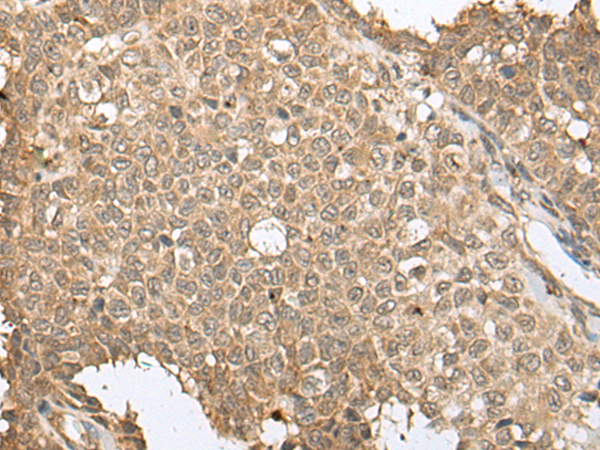

| WB | 咨询技术 | Human,Mouse,Rat |
| IF | 咨询技术 | Human,Mouse,Rat |
| IHC | 1/25-1/100 | Human,Mouse,Rat |
| ICC | 技术咨询 | Human,Mouse,Rat |
| FCM | 咨询技术 | Human,Mouse,Rat |
| Elisa | 1/5000-1/10000 | Human,Mouse,Rat |
| Aliases | DVC1; PRO4323; spartan; C1orf124 |
| Host/Isotype | Rabbit IgG |
| Antibody Type | Primary antibody |
| Storage | Store at 4°C short term. Aliquot and store at -20°C long term. Avoid freeze/thaw cycles. |
| Species Reactivity | Human, Mouse, Rat |
| Immunogen | Fusion protein of human SPRTN |
| Formulation | Purified antibody in PBS with 0.05% sodium azide and 50% glycerol. |
+ +
以下是关于 **SPRTN抗体** 的3篇代表性文献摘要,供参考:
---
1. **文献名称**:*SPRTN is a mammalian DNA-binding metalloprotease that resolves DNA-protein crosslinks*
**作者**:Lopez-Mosqueda J, et al.
**摘要**:该研究首次揭示了SPRTN作为金属蛋白酶的功能,证明其通过水解DNA-蛋白质交联(DPCs)维持基因组稳定性,并开发了特异性抗体用于检测SPRTN在细胞周期中的定位变化。
2. **文献名称**:*DNA-protein crosslink repair by SPRTN is regulated by ubiquitination and SUMOylation*
**作者**:Maskey RS, et al.
**摘要**:文章阐明了SPRTN活性受泛素化和SUMO化翻译后修饰的调控机制,并利用抗体免疫沉淀技术验证了其与p97/VCP复合物的相互作用,为癌症治疗提供潜在靶点。
3. **文献名称**:*Mutations in SPRTN cause early-onset hepatocellular carcinoma and genomic instability*
**作者**:Lessel D, et al.
**摘要**:该研究发现SPRTN基因突变导致患者早发性肝癌,通过抗体免疫组化证实突变体中SPRTN蛋白表达缺失,提示其作为肿瘤抑制因子的关键作用。
---
**注**:以上文献为领域内代表性研究,实际引用时请核对具体期刊名称、年份及卷期页码。如需实验用SPRTN抗体的商业来源,可参考Cell Signaling Technology或Abcam等厂商的产品说明。
SPRTN (also known as DVC1) is a metalloprotease critical for maintaining genome stability by resolving DNA-protein crosslinks (DPCs) during DNA replication and repair. DPCs are toxic lesions that block replication forks and transcription machinery, often caused by environmental agents (e.g., formaldehyde) or endogenous metabolites. SPRTN recognizes and cleaves covalently trapped proteins on DNA, enabling their proteasomal degradation. Mutations in SPRTN are linked to Ruijs-Aalfs syndrome, a progeroid disorder characterized by genomic instability, accelerated aging, and cancer predisposition.
SPRTN antibodies are essential tools for studying its role in DNA repair mechanisms. They are widely used in techniques like Western blotting, immunofluorescence, and immunoprecipitation to analyze SPRTN expression, localization, and interactions. Research using these antibodies has revealed SPRTN's recruitment to replication stress sites, its regulation by ubiquitination, and functional crosstalk with Fanconi anemia pathway proteins. Commercial SPRTN antibodies are typically validated in knockout cell lines to ensure specificity. Understanding SPRTN's molecular functions through antibody-based studies holds therapeutic potential for targeting DPC-related diseases, including cancer and premature aging syndromes.
×